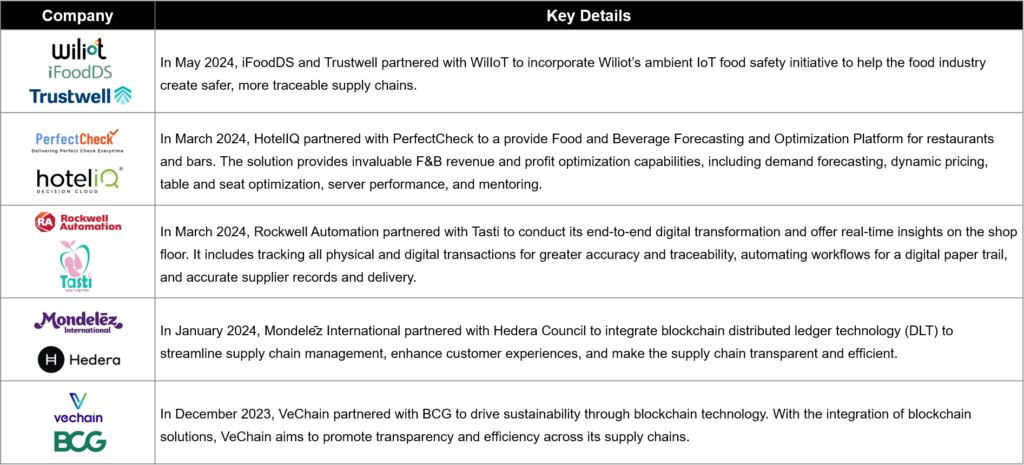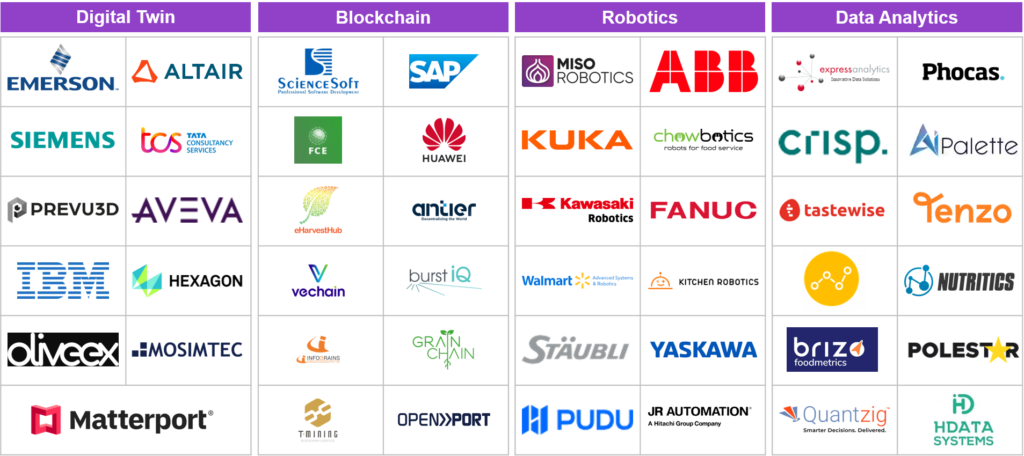The food and beverage industry is undergoing a huge transformation driven by digitalization technologies. It involves integrating advanced technologies like big data analytics, digital twins, blockchain, etc., into all industry areas, from production and processing to distribution and customer interaction.
In this transformative environment, various sub-systems from the food and beverage value chain are seamlessly communicated to eliminate the data silos; this enables the efficient and fast data analytics of the vast data sets to offer business insights and recommendations across all levels of management. These technologies will improve efficiency, food safety, better traceability, and the ability to meet changing consumer demands.
The upcoming article will explain how digitalization transforms the food and beverage industry and the latest trends, innovation areas, and use cases.
How is Digitalization Transforming the Food & Beverage Industry?
Integrating digital technologies into various production, processing, manufacturing, and more areas represents a digital transformation in the food and beverage industry. This transformation optimizes operations and reduces costs while enhancing product safety and fulfilling users’ changing demands in a technology-changing world.
Prominent Technologies for Digitalization in Food and Beverage
Various technologies such as blockchain, IoT, data analytics, robotics, and many more are integrated into the food and beverage industry. Implementing these technologies has significantly transformed the industry by improving efficiency, ensuring food safety, and improving customer experiences.

Figure 1: Prominent Technologies Used in Food and Beverage Industry
What are the Trends in Digitalization in the Food & Beverages Industry?
Innovations in digitalization are changing the food and beverage industry. Driven by the search for enhanced efficiency, transparency, and consumer satisfaction, they are shaping new trends that redefine production, distribution, and consumption patterns.

Figure 2: Trends in the Food and Beverage Industry
Key Innovation Areas
Technology innovations are revolutionizing the food and beverage industry and boosting efficiency, quality, and customer satisfaction. Some of the prominent innovation areas are given below:
Supply Chain
Innovation in supply chain management involves leveraging advanced technologies like AI, blockchain, IoT, etc., to enhance efficiency, traceability, and transparency. These innovations help streamline operations, reduce costs, and improve overall supply chain performance.
Key Innovations
- Digital Twin for Enhancing Food Supply Chain: Digital twins in the food supply chain enhance the resiliency of the food supply chain, food waste reduction, and sustainability. The digital twin grey causal modeling (GCM) can be utilized with its four-feature framework, including causes, effects, objectives, and outcomes. The framework collects the supply chain information to find the cause-and-effect factor responses. Further, the responses were collected to rank the identified cause-effect pairs for various objectives to calculate the outcomes. The digital twin framework outcome helps the industry stakeholders to decide the policies and practices to improve the supply chain.
- Blockchain-Driven Food Supply Chain Management: To enhance the food supply chain, a blockchain-based framework with the Elliptic Curve Integrated Encryption Scheme (ECIES) and XAI-Faster RCNN-based QR code scanning. The XAI-based Faster RCNN model is used to analyze the contents of food items and is integrated with a user-friendly web-based front-end design with QR code scanning capabilities. The QR code is used to access food information between manufacturers and end users at any time and location. Then, to ensure secure communication during supply chain management, each communication token is verified using an Elliptic Curve Integrated Encryption Scheme based on blockchain technology. Additionally, Artificial Rabbit Optimization registers each user and assigns them a unique key. The XAI-based Faster RCNN model will help turn information about food products into digital data, make it easy to access this information, and reveal any hidden details in QR codes that affect food safety.
Advanced Robotics
Robotics is a crucial innovation area for digitalization in the food and beverage industry. Robots have many utilities, including automating processes, quality control, pick-and-place, packaging, food delivery, etc., with improved efficiency, precision, quality, productivity, and reduced operational costs.
Key Innovations
- In-Restaurant Food Delivery Robot with Line Following Sensor: Autonomous food delivery robots improve restaurant operations by communicating with customers, delivering food, and ensuring satisfaction. These robots include various sensors such as LiDAR, ultrasonic, camera, and others, which are not important for restaurant use and make the robots costlier. To optimize the cost of the food delivery robots, “line following sensors” can be utilized along with the PID controller tuned with the Ziegler Nichols Method for in-restaurant navigation and obstacle avoidance.
- Robotic Arm Trajectory Tracking: In the food and beverage industry, robotic arm trajectory tracking is used to pick up and place operations during food processing, sorting, packaging, etc. The neural network terminal sliding mode control (ALSSA-RBFTSM) method can be used for robotic arm control, showing a fast and robust trajectory tracking performance. The ALSSA-RBFTSM is a fusion AI method that combines the features from different AI methods, including fast non-singular terminal sliding mode (FNTSM) control, radial basis function (RBF) neural network, and adaptive leader salp swarm algorithm (ALSSA).
Improving Cybersecurity
As an effect of digitalization, the food and beverage industry is adopting technologies like IoT, Blockchain, cloud computing, robotics, data analytics, etc. The adoption of these technologies opens the space for vulnerabilities. It can compromise data, enterprise networks, equipment, and other assets, which creates an extreme need for innovation in the cybersecurity domain.
Key Innovations
- Zero Trust Architecture: Zero Trust Architecture is an emerging security model that provides security with an application—and data-centric view. To enhance cybersecurity, the zero trust architecture can be integrated via micro-segmentation, continuous authentication, strict access controls, and other methods in the food and beverage industry, such as asset management, ERP applications, supply chain management, etc.
- Privacy-Preserving Data Analytics: As digitization progresses, a large amount of data is shared between different entities for data analytics prospects, which makes the data vulnerable to privacy and theft. To overcome this challenge, a privacy-preserving framework can be utilized, in which the data is encrypted with homomorphic encryption first and then shared with other entities using differential privacy schemes.
Reduction in Data Integration Complexity
Food and beverage industry digitalization handles data from different sources, such as IoT devices, production equipment, supply chain management, consumer management, etc. Integrating data from various sources into a unified system is challenging and time-consuming.
Key Innovations
- Middleware-Based Data Integration: To improve the integrity of data collected from different sources, data analytics can be integrated with a middleware layer that ensures the data is correctly formatted and standardized before being shared or recorded. The middleware layer comprises different APIs and micro-services, creating interoperable data components with minimal disruption.
- Semantic Data Integration: This is an innovative data integration technique for food and beverage industry tractability systems. To manage data from heterogeneous data sources like IoT devices, ERP systems, supply chain management software, regulatory databases, etc., ontologies and knowledge graphs are utilized for semantic interoperability. Ontologies describe the ideas and connections inside a certain domain, while knowledge graphs organize and link structured data to provide a comprehensive view of the information in an interoperable structure.
Use Cases
Digitalization in the Food & Beverage industry has many use cases, including IoT for real-time monitoring, blockchain for food traceability and transparency, big data analytics for optimizing supply chain management, and demand forecasting.
Nestle adopted Smart Inventory Management
Nestle has integrated IoT technology into its supply chain. It uses RFID tags and IoT sensors to monitor products throughout the supply chain. Real-time tracking helps optimize inventory management, minimize stockouts, and reduce excess inventory.
Benefits: Using these technology solutions, they enhanced their production planning, distribution, and customer service.
Molson Coors Beverage Company implemented IoT Temperature Sensors
Molson used an IoT-based temperature sensor to monitor its beer storage. The sensors are embedded in the beer storage to continuously track the temperature and humidity levels. If optimal conditions change, automated alerts are sent to the relevant person, allowing them to take corrective action.
Benefits: This ensures that the quality of the beer is maintained during storage, leading to higher product quality and customer satisfaction.
Walmart implemented Blockchain for Food Traceability
Walmart uses a blockchain-based system to track products from farm to shelf, monitoring parameters such as origin, processing methods, transportation conditions, and storage history to ensure product quality and safety. IoT sensors monitor temperature and other relevant parameters while transporting perishable goods.
Benefits: Their transparency is improving, and response times for safety recalls are reduced.
IBM Food Trust implemented IoT-based Food Safety
IoT sensors are integrated, and data is collected from many stakeholders in the supply chain, such as farmers, processors, distributors, and retailers. This information is used to track environmental conditions, shipping information, and handling practices, all of which are recorded in the blockchain.
Benefits: This data-driven approach ensures better food safety and quality control and provides consumers with valuable information about the products they purchase.
Market Insights
The market for digitalization in the food and beverage industry is observing activity, with many companies collaborating to provide innovative solutions. Key players such as IBM, Siemens, Emerson, and many more have introduced solutions that can be integrated into the industry.
Recent Activity
The food and beverage industry market is witnessing dynamic activity, with various companies implementing innovative solutions followed by mergers and acquisitions. Key players such as Trustwell, iFooDS, BCG, and many more have introduced technologies that can integrate into the Food and Beverage Industry.

Table 1: Market Activity
Prominent Players
The food and beverage industry consists of many established, active companies working in different technology domains to develop efficient, transparent, and sustainable solutions.

Figure 3: Prominent Players
Conclusion
Digitalization is transforming the food and beverage industry, driving improvements in efficiency, quality control, and customer engagement. Using advanced technologies like AI, IoT, and blockchain in the food industry comes with challenges, such as high implementation costs and cybersecurity risks; these challenges are being covered through strategic investments and robust security measures. In the future, the food and beverage industry will focus on integrating AIoT and Generative AI for enhanced automation, predictive analytics, and real-time monitoring.
Advances in AR, VR, and robotics will change customer engagement and operational efficiency. Focusing on cybersecurity and working with tech experts will be key to ongoing improvement and keeping up with the changing market.